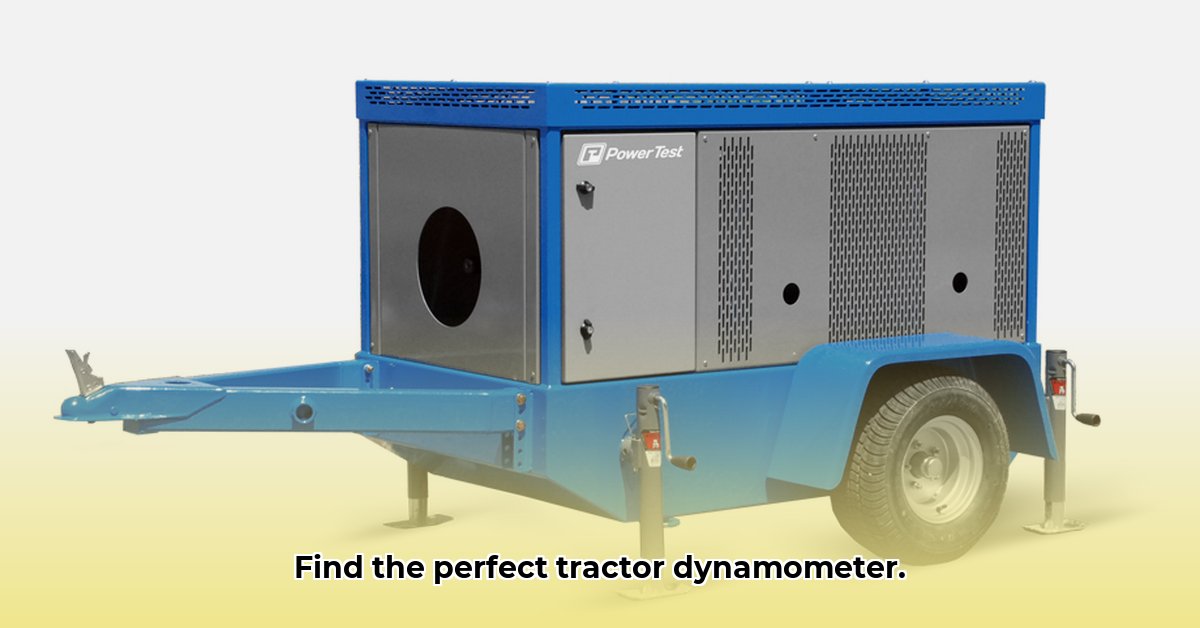
Tractor dynamometers are indispensable tools for accurately measuring tractor power output, crucial for optimizing farm efficiency and making informed equipment decisions. This comprehensive guide explores everything you need to know, from historical context to maintenance and troubleshooting, equipping you to select the perfect dynamometer for your operation. For even more information, check out this helpful resource: Tractor Dynamometer Guide.
A Blast from the Past: The Evolution of Tractor Power Measurement
Early methods of measuring tractor power were rudimentary, relying on simple load cells offering only a rough estimate of horsepower. These early systems lacked the precision of today's sophisticated dynamometers. The evolution has been remarkable, transitioning from basic water brakes to advanced hydraulic and electronic systems providing incredibly detailed and accurate data. This technological leap reflects the wider advancements in agricultural technology and the increasing demand for data-driven decision-making in farming.
Different Dynamometers, Different Needs: Understanding Your Options
Various types of tractor dynamometers cater to diverse needs and budgets. Each offers unique advantages and drawbacks:
Water-Cooled Dynamometers: These robust systems use water to dissipate the significant heat generated during testing. Ideal for extended, high-intensity use, they require a consistent water supply and a method for managing the used water. They are often a cost-effective choice for lower-horsepower tractors.
Hydraulic Dynamometers: More compact and portable than water-cooled counterparts, these dynamometers use hydraulic fluid to manage heat and provide precise readings. They usually allow for a broader range of power absorption. While convenient, they often come at a higher price point.
Eddy Current Dynamometers: Utilizing electromagnetic fields to create resistance, these advanced systems offer smooth load control and efficient operation. However, their sophisticated technology typically translates to a higher initial investment.
The optimal choice depends heavily on your budget, the frequency of testing, and the size of tractors you'll be evaluating.
Key Features and Specifications: Getting the Most for Your Investment
Beyond the dynamometer type, several key specifications demand careful consideration:
Horsepower Capacity: This crucial factor must match or exceed the highest horsepower rating of the tractors you intend to test. Underestimating this can lead to equipment damage.
Torque Measurement Accuracy: Precision is paramount. Look for dynamometers with a low percentage of error in torque measurement. Higher accuracy translates to more reliable test results. This will significantly impact the tuning and optimization of your tractors.
Repeatability: A reliable dynamometer yields consistent readings under identical conditions. Lower repeatability error signifies greater precision and reliability in your testing.
Data Logging and Software Integration: Modern dynamometers often include software for recording, analyzing, and storing data. This data is invaluable for ongoing maintenance and performance improvement. Look for compatibility with relevant farm management systems.
Choosing Your Dynamometer: A Step-by-Step Guide
Investing in a dynamometer requires a strategic approach. Follow these steps for a successful purchase:
Assess Your Needs: Determine the size of your tractors, the frequency of testing, and your budget. A realistic assessment is fundamental.
Research Different Models: Compare specifications from reputable manufacturers. Pay attention to customer reviews and seek input from fellow farmers.
Request Demonstrations: Before purchasing, request a demonstration to witness the dynamometer's performance and test it with your tractors. This hands-on experience is crucial.
Consider After-Sales Service and Support: A robust warranty and responsive customer service are critical. Issues can arise, and prompt support is essential.
Maintenance and Troubleshooting: Ensuring Long-Term Performance
Regular maintenance is key to maximizing your dynamometer's lifespan and accuracy. Always adhere to the manufacturer's instructions. Common issues include:
Leaks: Regularly inspect hydraulic lines and seals for leaks. Addressing minor leaks prevents larger, more costly problems later.
Calibration Issues: Regular calibration ensures accuracy. The frequency depends on manufacturer recommendations.
Software Problems: Keep the dynamometer's software updated for optimal functionality.
Tailoring Your Approach: Actionable Advice for Different Stakeholders
The benefits of tractor dynamometers extend to various players in the agricultural sector:
Dealerships: Thorough staff training maximizes the value you provide to customers. Integrating dynamometer data into service offerings enhances efficiency and boosts customer satisfaction.
Manufacturers: Keeping abreast of dynamometer technology trends allows for the integration of diagnostic information into warranty programs. This can facilitate proactive maintenance and increase customer loyalty.
Engine Rebuilders: Strong relationships with reliable vendors are crucial. Advanced diagnostic software significantly improves your diagnostic and repair capabilities, potentially reducing turnaround time.
Investing in the right tractor dynamometer is a strategic decision for any farmer prioritizing efficiency and profitability. By carefully considering the available options and following the steps outlined above, you can make a confident purchase which will provide significant returns over the long term.